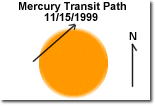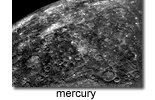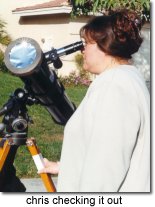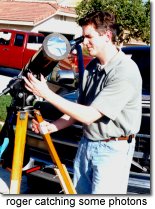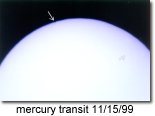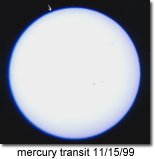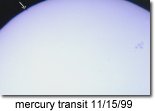|
Mercury
Transit - 11/15/1999
|
|
A little transit for your Monday?
On Monday, November 15th, 1999, the planet Mercury crossed in front of the Sun, providing some entertainment for those with proper filtering on their telescopes or binoculars.
What happened?
The transit, which is the term for an event in which one solar system body crosses in front of another body from our perspective, went off as predicted and was visible throughout Asia and North America. In this case, the planet Mercury traveled across the north-west limb of the Sun, doing so for about and hour, and then exited as noted in the diagram above (the diagram is pretty exaggerated as well - Mercury never got that far into the Sun's disk as you'll note in the images). It occurred in California around 1:11pm PST and lasted until roughly 2:10pm PST, although it went out of view of my viewing apparatus long before that point. I lost sight of Mercury around 2pm.
My adventure...
I went home for a "late lunch" to view and photograph the event. Armed with my 4.5" Newtonian telescope, Baader solar film filter which I'd just gotten that week, and a Nikon FM2N camera, I lined up to do battle with this phenomenon.
The observation wasn't terribly exciting for everyone. After all, its just a sun-spot looking thing on the limb, and there were a few real sun-spots elsewhere that day. So one could easily have yawned and moved on. In my case however, even my wife, who rarely gets out to observe anything at night, came out to view and was sufficiently impressed.
GEEK NOTES: I tried to pay attention to the dynamics of this event, and did note that there were a few ways to tell that this wasn't an ordinary sun-spot, just as our ancestors (those with telescopes and filters) probably did. First of all, Mercury moved across the Sun very quickly when compared to the slow moving sun-spots, who's apparent positions didn't seem to change in the time I was watching (the equator of the Sun rotates once in a ~25.4 day period, although sun-spots can come and go in that time period). Secondly, if I was paying attention and noting where the spots were over time I'm sure that I would have noticed some sun-spot movement and made note that they moved fairly horizontally from our perspective, where Mercury sped across at a different angle.
Any way, those geek observations aside, it seemed to impress everyone that stopped to take a look, even a couple of landscape workers that happened by. One of the most interesting visitors of the day came from a retired neighbor who mentioned that he'd never looked through a telescope - ever. As someone that regularly messes with telescopes, that was a foreign concept to me, but he hadn't and was excited to do so. So the transit didn't disappoint.
Photographing Techniques
I'd never done much solar observing. I didn't have a filter until that week, and had NEVER done any of my own solar photography. Please keep that in mind when judging the validity of my statements and techniques. The equipment:

